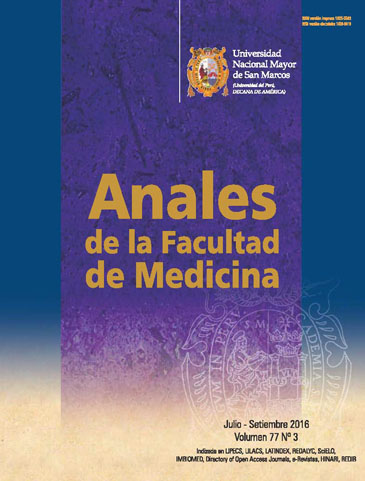Perception of bullying in sixth year students of a Lima public university school of medicine 2015
DOI:
https://doi.org/10.15381/anales.v77i3.12406Keywords:
Violence, Bullying, Stress, Students, Teachers.Abstract
Introduction. Aggressive and discriminatory behavior affects physical and mental health even on those who commit them. Students are subjected to stress, which increases the risk of those behaviors and makes them likely to suffer from its consequences. On the other hand, the Medical School aims to educate medical professionals integrally, with abilities to avoid violence and live peacefully. That is why the interest of describing this problem in Universidad Nacional Mayor de San Marcos, Lima, Peru’s Medical School. Objective. To address violence in students from the sixth year of Human Medicine who had not participated in the Integral Formation Program in UNMSM. Design: Descriptive, transversal study. Setting. "Instituto Nacional del Niño", Lima, Peru, teaching hospital. Participants. Sample consisted in 93 (63%) students enrolled in the sixth year of the Faculty of Medicine who took the course of Pediatrics during the months of July to November 2015. Interventions. An instrument developed and validated by the Spanish Office of the Ombudsman, modified and corrected by Hoyos et al was used. Frequencies and percentages of responses were calculated. Results. Violent behaviors were more prevalent among students; the most practiced behavior was to express badly (40.8%). Conclusions. The existence of violence occurs in a high percentage of the studied population; teachers and students are involved.Downloads
Published
2016-10-12
Issue
Section
Artículo Original
License
Copyright (c) 2016 Miguel Oliveros Donohue, Alberto Perales Cabrera, Salomón Zavala Sarrio, Isabel Amemiya Hoshi, Miguel Angel Pinto Salinas, Anthony Jazet Ramos Yataco

This work is licensed under a Creative Commons Attribution-NonCommercial-ShareAlike 4.0 International License.
Those authors who have publications with this magazine accept the following terms:
- Authors will retain their copyrights and guarantee the journal the right of first publication of their work, which will be simultaneously subject to Creative Commons Attribution License that allows third parties to share the work as long as its author and its first publication this magazine are indicated.
- Authors may adopt other non-exclusive licensing agreements for the distribution of the version of the published work (eg, deposit it in an institutional electronic file or publish it in a monographic volume) provided that the initial publication in this magazine is indicated.
- Authors are allowed and recommended to disseminate their work over the Internet (eg: in institutional telematic archives or on their website) before and during the submission process, which It can produce interesting exchanges and increase quotes from the published work. (See El efecto del acceso abierto ).
How to Cite
1.
Oliveros Donohue M, Perales Cabrera A, Zavala Sarrio S, Amemiya Hoshi I, Pinto Salinas MA, Ramos Yataco AJ. Perception of bullying in sixth year students of a Lima public university school of medicine 2015. An Fac med [Internet]. 2016 Oct. 12 [cited 2024 Jul. 17];77(3):231-6. Available from: https://revistasinvestigacion.unmsm.edu.pe/index.php/anales/article/view/12406















